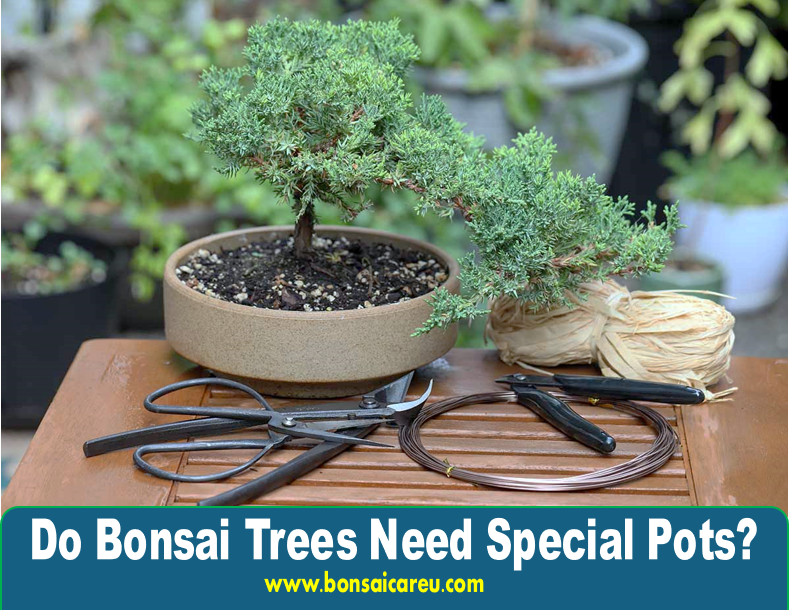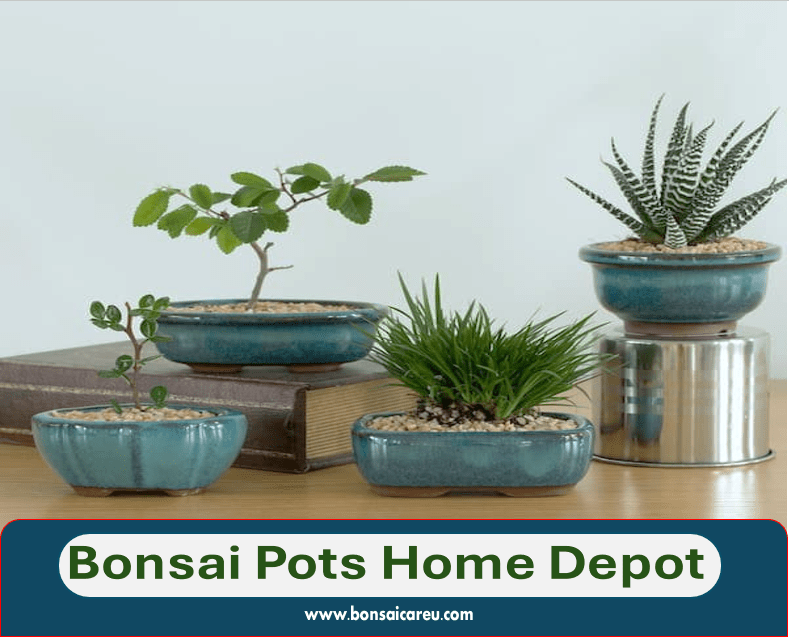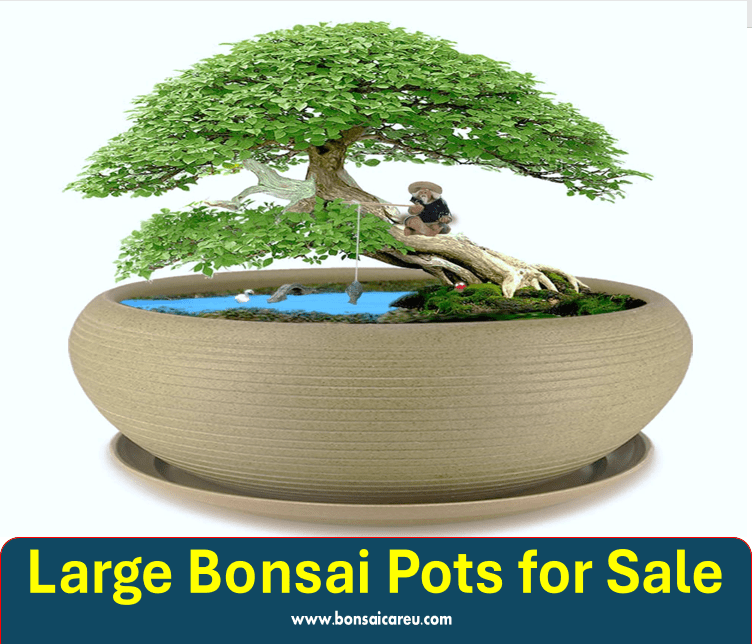Do Bonsai Trees Need Special Pots? Bonsai trees require special pots to control root growth and maintain their miniature size. The shallow pots limit root spread, aiding in tree development.
Bonsai trees are unique and delicate plants that require special care and attention. One crucial aspect of caring for a bonsai tree is selecting the right pot. Bonsai pots play a significant role in the overall health and growth of the tree.
These pots are specifically designed to restrict the root system’s growth, which helps maintain the tree’s compact size and aesthetic appeal. In addition to size considerations, bonsai pots come in various shapes, colors, and materials, each serving a specific purpose in the tree’s development. Understanding the importance of bonsai pots and selecting the right one for your tree can ensure its long-term health and vitality.

Choosing The Right Pot
Bonsai trees require special pots to ensure their health and proper growth. The right pot not only complements the aesthetic appeal of the bonsai but also plays a crucial role in its overall well-being. When it comes to selecting the perfect pot for your bonsai, several factors to consider include size, drainage holes, and the material of the pot.
Selecting The Perfect Size
The size of the pot is essential for the healthy growth of a bonsai tree. It should provide enough room for the roots to spread out and grow, but not be too large as it can lead to overgrowth. Generally, the pot’s width should be about two-thirds the tree’s height, allowing ample root space and providing stability.
Considering Drainage Holes
Drainage holes are crucial for the overall health of the bonsai tree. They allow excess water to escape, preventing root rot and waterlogging. The roots can suffocate without proper drainage, leading to the tree’s decline. Ensure that the pot has adequate drainage holes to maintain the right moisture levels for the tree.
Material Matters: Ceramic Vs. Plastic
The material of the pot plays a significant role in the growth of the bonsai tree. Ceramic pots are popular for their aesthetic appeal and ability to insulate the roots from temperature fluctuations. On the other hand, plastic pots are lightweight, durable, and provide better moisture retention. Consider the specific needs of your bonsai tree when choosing between ceramic and plastic pots.
Planting Techniques
Planting techniques are crucial for the health and growth of your bonsai tree. Proper techniques can ensure optimal development and aesthetics.
Off-centered Planting
Planting your bonsai slightly off-center in the pot can create a more natural and visually appealing composition.
Enhancing Aesthetics With Sphagnum Moss
Adding a layer of sphagnum moss at the bottom of the pot can help retain moisture and improve the overall appearance of your bonsai tree.
Soil Mix For Optimal Growth
Choosing the right soil mix is essential for the optimal growth of your bonsai tree. A mix of Akadama, Pumice, and Lava Rock provides proper drainage and nutrient control.
Quality Bonsai Pots
Quality bonsai pots are essential for properly growing and maintaining bonsai trees. The right pot should have proper drainage and wiring holes and be appropriately sized to control the tree’s growth. Substrates like Akadama, Pumice, and Lava Rock can provide better nutrient control and drainage.
Identifying High-quality Pots
Bonsai trees require pots that are aesthetically pleasing and high quality to support their growth and development.
High-quality bonsai pots are typically made from durable materials such as ceramic, mica, or high-fired clay, which provide adequate drainage for the tree’s roots.
Longevity And Durability
Investing in quality bonsai pots ensures longevity and durability for your tree. These pots are designed to withstand the test of time and resist cracking or damage.
With proper care, a high-quality bonsai pot can last for years, providing a stable environment for your tree to thrive.
Alternative Potting Options
Bonsai trees are traditionally potted in ceramic pots, but alternative options can also be effective. Whether you are looking for a more affordable option or a pot that offers specific benefits, considering alternative potting options for your bonsai tree can provide flexibility and customization.
Plastic Pots As Substitutes
Plastic pots can be a suitable substitute for ceramic pots when potting bonsai trees, especially for trees in training. They are cost-effective, durable, and nearly unbreakable, making them a practical choice for beginners or for trees that require frequent repotting. Additionally, plastic pots offer excellent drainage and aeration for the bonsai roots, contributing to the overall health and development of the tree.
Benefits Of Using Mica Pots
Mica pots are another alternative option that provides several benefits for bonsai trees. These pots are lightweight, making them easy to move and handle, and they also offer good insulation, protecting the roots from extreme temperatures. Additionally, mica pots are porous, promoting air circulation and preventing waterlogging, which can be advantageous for maintaining the optimal moisture levels for the bonsai tree.
Optimizing Growth With Special Soil Mix
Role Of Akadama
Akadama is crucial in bonsai soil mixtures, providing excellent moisture retention and aeration for optimal root growth.
Pumice
Pumice is essential in bonsai soil mixes as it helps improve drainage and prevent root rot by promoting airflow.
Lava Rock
Lava rock enhances soil structure and drainage, ensuring proper water distribution and nutrient absorption for healthy bonsai growth.
Improving Drainage And Nutrient Control
Proper soil mix containing Akadama, pumice, and lava rock is essential for maintaining adequate drainage and controlling nutrient levels in bonsai pots.

Frequently Asked Questions For Do Bonsai Trees Need Special Pots
What Is The Rule For Bonsai Pots?
Bonsai pots should have drainage and wiring holes and be slightly off-centered for aesthetic appeal. Plastic pots are suitable for training trees while using substrates like Akadama, Pumice, and Lava Rock can improve drainage and nutrient control during repotting. The pot size should accommodate the current root system of the tree.
Why Are Bonsai Pots So Shallow?
Bonsai pots are shallow to limit root growth, controlling tree size and development for miniature versions of larger trees.
What Can I Use For Bonsai Pots?
You can use plastic pots as a substitute for ceramic ones, especially for training trees. They are cheaper, durable, and almost unbreakable. Substrates like Akadama, Pumice, and Lava Rock can also provide better drainage and nutrient control.
Do You Need Special Potting Mix For Bonsai?
A special potting mix is unnecessary for bonsai but substrates like Akadama, Pumice, and Lava Rock enhance drainage and nutrient control during repotting. Plastic pots are a cost-effective and durable alternative to ceramic pots for bonsai training.
What Kind Of Pot Is Best For Bonsai Trees?
Choosing a pot for your bonsai is crucial as it affects the tree’s growth and development. Generally, bonsai pots should be shallow, with proper drainage and wiring holes for fixing the tree.
Can I Use A Regular Pot For My Bonsai Tree?
It is not recommended while you can technically use a regular pot for your bonsai tree. Bonsai pots are designed to restrict the tree’s growth and are better suited for the fine branches and roots of bonsai trees.
Conclusion
When choosing a pot for your bonsai, consider the size, material, and drainage. The right pot can enhance the beauty and health of your tree. Remember to repot your bonsai periodically to ensure proper growth. With the right pot, your bonsai will flourish for years to come.


